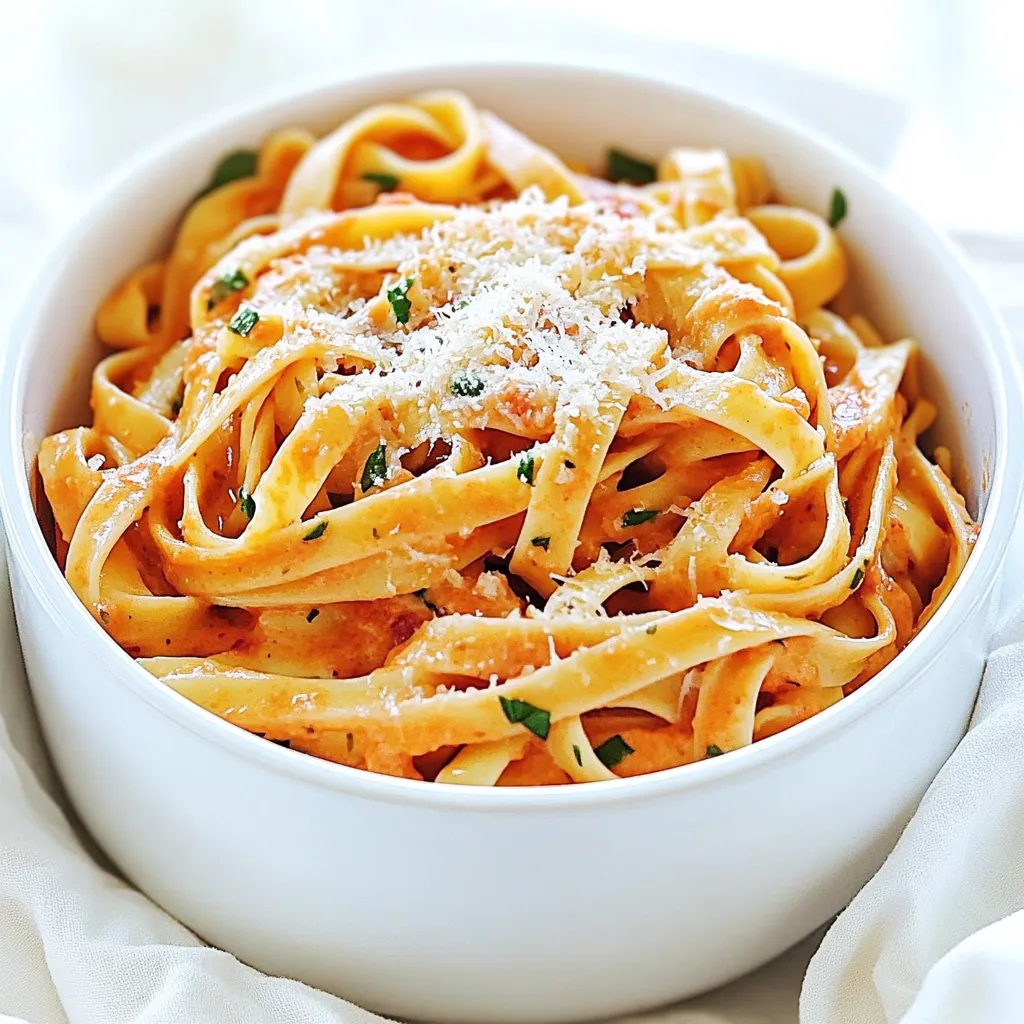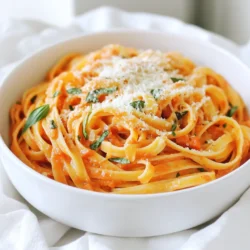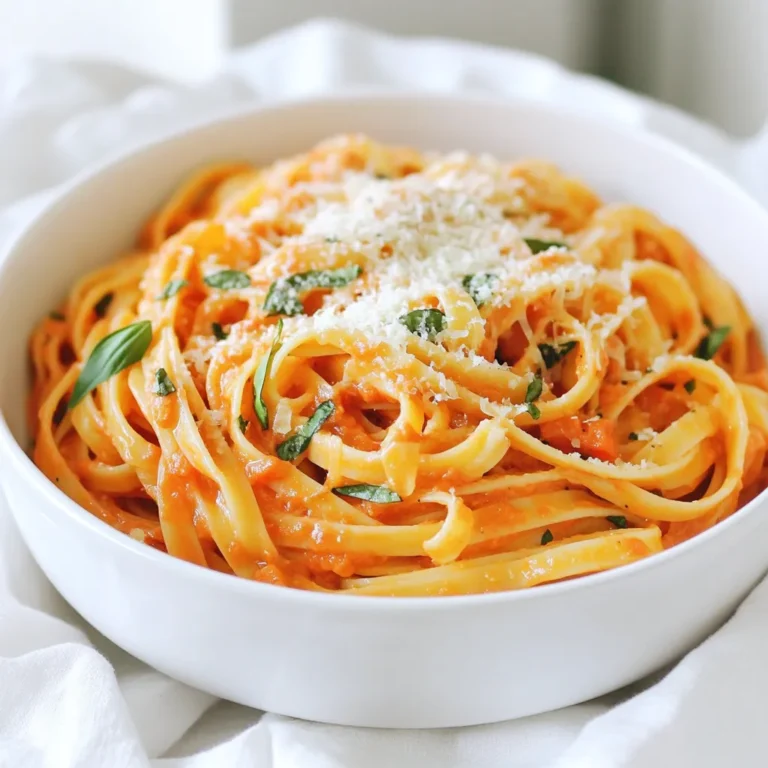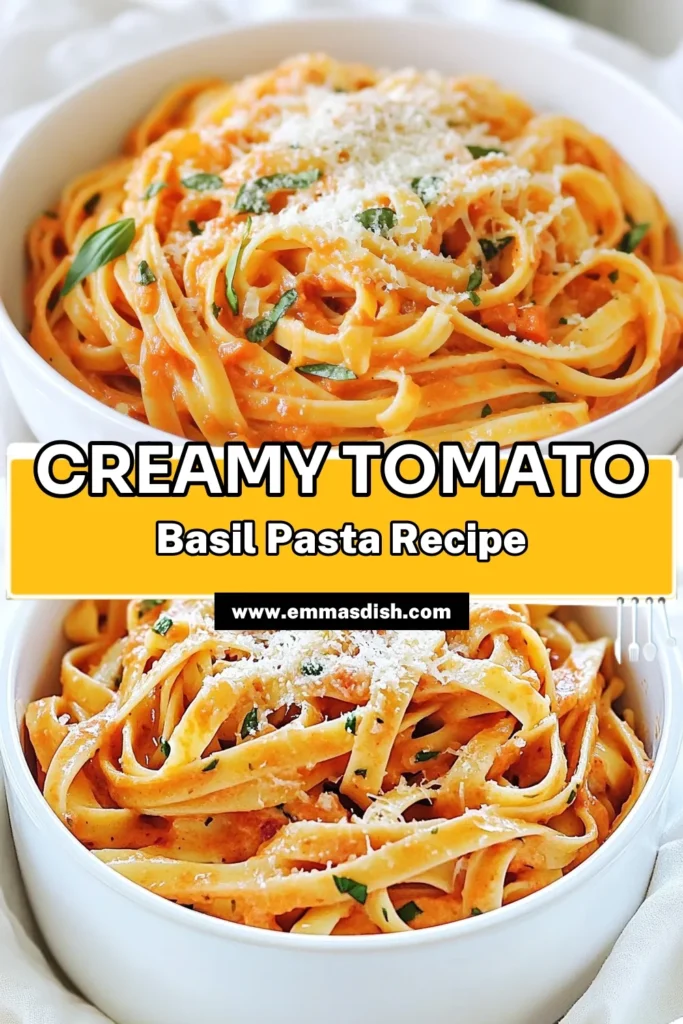Are you craving a simple yet delicious meal? Look no further! My Creamy Tomato Basil Pasta is easy to make in just one pot. Using fresh ingredients, this dish bursts with flavor and warmth. Whether you’re a busy parent or a student on the go, you’ll love how quick and satisfying this recipe is. Let’s dive into the ingredients and learn how to whip up this delightful meal in no time!
Ingredients
Main ingredients for Creamy Tomato Basil Pasta
To make this dish, you need simple ingredients that pack a punch. Here’s what you’ll need:
– 12 oz fettuccine or pasta of choice
– 2 tablespoons olive oil
– 1 small onion, finely chopped
– 3 cloves garlic, minced
– 1 can (14 oz) crushed tomatoes
– 2 cups vegetable broth
– 1 cup heavy cream or coconut cream for a dairy-free option
– 1 teaspoon dried oregano
– 1 teaspoon sugar
– Salt and pepper to taste
– 1 cup fresh basil leaves, roughly chopped
– Grated Parmesan cheese for serving (optional)
These ingredients create a creamy, rich sauce that clings to the pasta perfectly.
Optional ingredients for customization
You can change this recipe to suit your taste. Here are some ideas:
– Spinach for extra greens
– Red pepper flakes for heat
– Mushrooms for a hearty bite
– Sun-dried tomatoes for more depth
Feel free to mix and match to find your favorite flavors!
Tips for choosing the best pasta
The pasta choice can change the dish’s texture. Here’s what I recommend:
– Use fettuccine for a classic feel.
– Try penne for a fun twist.
– Look for whole grain or gluten-free options if needed.
Always check the cooking time on the package and adjust your cooking process accordingly. This ensures a perfect pasta that holds the sauce well.
Step-by-Step Instructions
Preparation steps for one pot cooking
To start, gather all your ingredients. This makes cooking easier. You will need:
– 12 oz fettuccine or pasta of choice
– 2 tablespoons olive oil
– 1 small onion, finely chopped
– 3 cloves garlic, minced
– 1 can (14 oz) crushed tomatoes
– 2 cups vegetable broth
– 1 cup heavy cream or coconut cream for a dairy-free option
– 1 teaspoon dried oregano
– 1 teaspoon sugar
– Salt and pepper to taste
– 1 cup fresh basil leaves, roughly chopped
– Grated Parmesan cheese for serving (optional)
Next, chop the onion and mince the garlic. These will add great flavor.
Detailed cooking process
In a large pot, heat the olive oil over medium heat. Once hot, add the chopped onion. Sauté it for about 5 minutes until it turns soft and clear.
Now, stir in the minced garlic and cook for about 1 minute. You want it to smell great but not burn.
Add the crushed tomatoes, vegetable broth, dried oregano, and sugar. Stir everything well to mix.
Bring the mix to a simmer. Then, add the pasta. Make sure the pasta is fully covered in the sauce.
Cover the pot and cook for 10-12 minutes. Stir occasionally, so the pasta cooks evenly. You want it al dente, which means it should be firm but not hard.
After cooking, reduce the heat to low. Stir in the heavy cream or coconut cream. Mix until it blends well.
Now, add the fresh basil and season with salt and pepper to taste.
Remove the pot from heat and let it sit for a few minutes. This helps the sauce thicken.
Tips for achieving creamy consistency
To get that nice creamy texture, you must stir the cream in well. If you notice it’s too thick, add a bit more vegetable broth.
Using high-quality cream helps too. If you want a dairy-free option, coconut cream gives a lovely flavor.
Always taste and adjust the seasonings. This makes sure every bite is full of flavor.
Letting the dish rest for a few minutes after cooking helps it thicken. Enjoy your creamy tomato basil pasta!
Tips & Tricks
How to enhance flavor
To boost the flavor of your creamy tomato basil pasta, try adding a pinch of red pepper flakes. This will give it a nice kick. You can also toss in a splash of balsamic vinegar. It adds a sweet tang that brightens the dish. Fresh herbs are key too. Add extra basil or even some parsley for freshness.
Suggestions for making it dairy-free
You can make this dish dairy-free by using coconut cream instead of heavy cream. It gives a rich taste without the dairy. If you want a lighter option, try unsweetened almond milk. Use nutritional yeast to add a cheesy flavor without dairy. It’s a great choice for those avoiding animal products.
Cooking tips for perfect pasta texture
To get your pasta just right, start with a large pot of boiling water. Salt it well before adding the pasta. This helps flavor the noodles. Stir the pasta often while it cooks. This keeps it from sticking together. Cook until just al dente; it will continue to cook in the sauce. If it seems too dry, add a little extra broth or water while it cooks.

Variations
Different pasta types to try
You can use many pasta types with this creamy tomato basil dish. Fettuccine works great, but you can also try penne, rigatoni, or even spaghetti. Each type adds a unique twist. Short pasta holds the sauce well, while long pasta gives a lovely presentation. You may even choose whole wheat or gluten-free pasta for a healthier option.
Adding protein options (chicken, shrimp, etc.)
Adding protein makes the meal more filling. Grilled chicken or shrimp are excellent choices. Simply cook them separately and mix them in at the end. You can also use sautéed mushrooms or chickpeas for a vegetarian option. These proteins blend well with the creamy sauce and add a nice texture.
Customizing with seasonal vegetables
Seasonal veggies bring freshness to your dish. Spinach, zucchini, or bell peppers work well. Just chop them and add them when you mix in the cream. This step gives your pasta extra flavor and nutrients. You can also use cherry tomatoes for a sweeter touch. Mixing in seasonal veggies makes the meal colorful and fun!
Storage Info
Best practices for storing leftovers
Store any leftover creamy tomato basil pasta in an airtight container. Make sure it cools down first. This keeps the flavors fresh and helps avoid sogginess. You can store it in the fridge for up to three days. If you plan to eat it later, it’s best to keep the pasta and sauce separate. This will help maintain the texture.
Reheating tips for optimal taste
When it’s time to reheat, do it gently. You can use the stove or microwave. If using the stove, add a splash of water or broth to help loosen the sauce. Heat it over low heat, stirring often. If using the microwave, heat it in short bursts. Stir between each burst to ensure even heating. This way, the pasta stays creamy and tasty.
Freezing suggestions and duration
You can freeze creamy tomato basil pasta, but it’s best to freeze just the sauce. Cooked pasta may become mushy when thawed. Store the sauce in a freezer-safe container for up to three months. When ready to use, thaw it overnight in the fridge. Then, cook fresh pasta and mix it with the thawed sauce for a delightful meal.
FAQs
Can I make this dish ahead of time?
Yes, you can make this dish ahead. Cook the pasta and sauce, then cool it down. Store them in a container. When ready to eat, just heat it on the stove. Add a splash of broth to keep it creamy. This will save time on busy nights.
What can I substitute for heavy cream?
You can use coconut cream for a dairy-free option. It gives a nice richness. You can also try cashew cream. Just blend soaked cashews with water until smooth. Both options will keep your pasta creamy and tasty.
How can I make this recipe gluten-free?
To make this dish gluten-free, choose gluten-free pasta. There are many great options now. Look for rice, corn, or quinoa pasta. They cook well and taste great. Follow the same steps, and you’ll have a yummy gluten-free meal.
What are some good side dishes to serve with it?
You can serve a fresh salad as a side. A simple green salad with vinaigrette works well. Garlic bread also pairs nicely. It soaks up the creamy sauce. Roasted veggies can add color and flavor. Choose what you love!
This guide covered everything you need for creamy tomato basil pasta. We explored main and optional ingredients, ensuring you can customize your dish. I shared step-by-step instructions and tips for a creamy texture. We discussed variations with different pasta types and proteins, plus how to enjoy seasonal veggies.
Finally, proper storage and reheating help you enjoy leftovers. Remember, with these tips, you can make this dish your own. Enjoy your cooking adventure!



